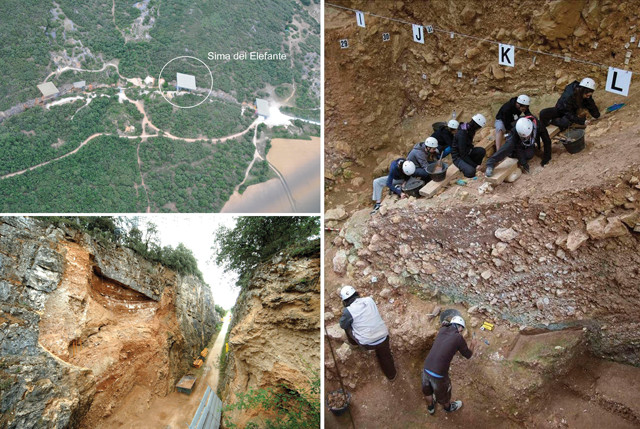
by Mary Caperton Morton Wednesday, March 29, 2017

The Sima del Elefante site is located near the famous Sima de los Huesos hominin site in Spain's Atapuerca Mountains. Credit: Hardy et al., The Science of Nature, December 2016.
Ancient teeth have long been a source of information about ancient diets, mainly through analyses of isotopic compositions and wear patterns. In a new study published in the Science of Nature, researchers studied microfossils of food particles extracted from the teeth of a 1.2-million-year-old unidentified hominin found at the Sima del Elefante site in northern Spain. The microfossils include traces of raw animal tissue, uncooked starch granules from grasses, pollen grains from a species of pine tree and insect fragments. The lack of charring of the recovered fibers and an absence of micro-charcoal suggest the bearer of the teeth neither cooked his or her food nor spent significant time around a fire source.
“These results are very exciting, as they highlight the potential of dental calculus to store dietary and environmental information from deep in the human evolutionary past,” said co-author Anita Radini of the University of York in England in a statement. “It is also interesting to see that pollen remains are preserved often in better condition than in the soil of the same age.”
The find lends support to a body of evidence indicating that controlled fire use for cooking didn’t begin in Europe until about 800,000 years ago. Indications from sites in Africa, however, suggest that fire may have been used as early as 1.8 million years ago, but those findings are contested.
“Cooked food provides greater energy, and cooking may be linked to the rapid increases in brain size that occurred from 800,000 years ago onwards,” said lead author Karen Hardy, also of the University of York, in the statement.
© 2008-2021. All rights reserved. Any copying, redistribution or retransmission of any of the contents of this service without the expressed written permission of the American Geosciences Institute is expressly prohibited. Click here for all copyright requests.